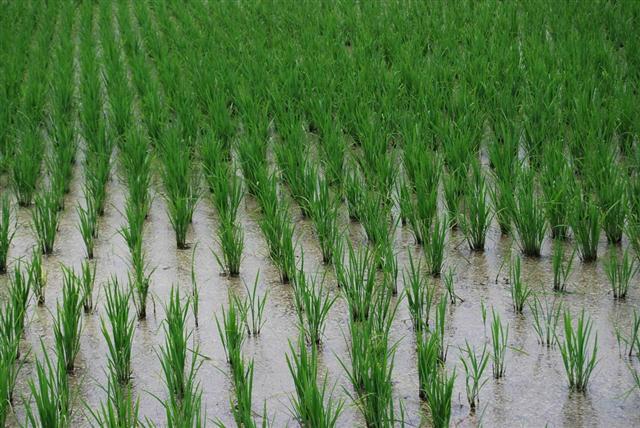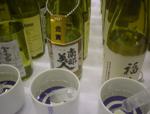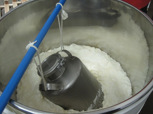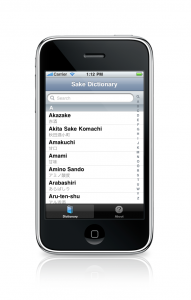|
|
|
June Greetings to all readers,
 |
|
As spring gives ground grudgingly to summer - albeit through the just-begun l-o-n-g rainy season - a bit of a lull sets into the sake world. The number of tastings and events tapers a bit, most brewers are finished for the season, and can begin to focus on sales, cleanup, and maintenance – all after some much-needed rest!
Freshly-pressed young sake begins to yield to light and toned-down summer ginjo types, at least from some brewers. And just about now, much of the rice that will be going into next season’s sake will begin to be grown. This month, let us look at the unique system for distributing rice to sake brewers in Japan, at least as much as its opacity (the system, not the rice, although that is pretty opaque as well) will allow.
I will hold the summer’s Sake Professional Course August 8, 9 and 10 in Dallas, Texas, in conjunction with TEXSOM 2013. There are about ten seats remaining right now, and you can learn more below. If you are anyone else are interested, by all means send me an email to that purport.
And please enjoy the newsletter!
John
|
|
Rice Distribution in the Sake World
It's complicated...
One of the more idiosyncratic aspects of the sake world is the distribution system via which brewers get their rice. It certainly is not simple, and at one time it probably made sense. Certainly there are many that benefit from it – both brewers and farmers – and others for whom it serves them less. And, of course, there are those that have the means and cleverness to work around it if need be. Let’s look at it a bit more closely.
The place to begin is to realize that sake brewers do not grow their own rice. Fundamentally speaking, since just after World War II, companies, i.e. business entities are not permitted to grow rice. All rice is grown and sold by individual farmers. Business entities are basically not allowed to be involved. Things have changed a little bit recently and there are some exceptions, but basically sake brewers cannot own their own rice fields, or grow their own rice.
Why is this the case? It is to prevent the reconsolidation of farmland. Long ago, owners of huge tracts of land controlled things, rather than the peasants living on it and growing on it. For reasons beyond my comprehension (although my sense of common decency says it’s not cool) this is not a stable situation economically. Regardless of the reasoning, this keeps rice plots spread out and small, with the average being about 1.65 acres, compared to farms typically 160 times that in the US.
 |
|
This lead to the creation of agricultural cooperatives, about which more could be written than the scope of this newsletter can hope to contain. But in short, local farmers have their rice distributed to the market through local agricultural co-ops, from whom they are often obligated to buy fertilizers, insecticides and more. But these co-ops then negotiate prices and secure livelihood for the local farmers and others. They are also necessarily competitive organizations, and do their best to promote the brands of rice that grow best in their region.
And for many brewers, this is the easiest way to go. They order a certain rice grown in a certain region, and almost always, they will get it. They cannot specify just who the grower is, just the variety, inspected grade, and region. And while sometimes shortages do occur, almost always they get what they ordered.
Then, a scant 15 years ago or so, laws changed that allowed brewers to bypass the co-ops and form contracts with farmers to buy rice directly. This is great for a number of reasons. They can “see the faces” of the producers, dictate a bit more about how it is grown if they want to, and see it at every step of its evolution. However, there are downsides as well to going with single producers via contract.
For example, what if there is a bad year, and harvested amounts are low? When one buys from an agricultural co-op that draws from many growers, it is easy to cover those shortages. Sure, somebody somewhere gets stiffed, but it’s a game of supply and demand, and who orders first.
But if they buy from one farmer drawing from just a few fields, a bad year means less rice, which must then be bought later, elsewhere, and may be neither the quality level or price that was initially sought.
And what if there is a bumper crop? While that sounds great, it might not be. Again, buying from a co-op is no problem. “You ordered this much, you get this much. The surplus is our problem.” But if you buy it via contract on a field, if they have bumper crop, you are stuck with paying for and then dealing with all that excess rice that grew on that field. After all, the grower reserved it all for you. And while you might be tempted to think, “Well, just make more sake with it!” it is not that simple practically, economically or even legally.
Of course, there are ways to work around both of the above issues; the point here is simply to show the pros and cons of each, and how big an issue procuring rice is for sake brewers.
Only about 1.4% of all rice grown in Japan is sake rice. Obviously, it is not a cash crop, nor the priority for most farmers, or the co-ops. Wide plains are reserved for more lucrative-to-grow table rice, and often sake rice gets relegated to the harder-to-till parcels. Not always, mind you; but often.
Also, a few years back, it became legal for brewers themselves (actually, some business entities) to grow rice. One would think, “Hey, now this changes everything, duddn’t it!” But in reality, very few have begun to do that. A few have, and surely others welcome the idea in concept. But gearing up to farm when you do not have the people, experience and tools is major hassle, and on top of that, the relationships with those that can do it well are in place. Let it ride.
But in truth there are many patterns. One brewer I know well maintains about 25 fields around his region, small parcels of land that are owned by folks too old to work them anymore. My brewer friend rents them for very little, and it is win-win as he gets to grow his rice his way, and he keeps the land arable too, which the owners like.
“It has its attendant issues,” he lamented hesitatingly. “Often, those old folks can be a pain in the ass.”
Why then, I suggested, do you not just buy the land from them? The terseness of the wave of his hand with which he dismissed that suggestion clearly conveyed its ridiculousness.
“Land prices are high; profit margins on rice and sake are miniscule. It would take me well over a full century to reap a return on my investment!”
So while many brewers might the romantic notion of growing their own sake rice, it is often not a practical option.
As rice distribution really is a murky and vague topic, let us look at it again in next month’s newsletter, when we will see how government allocations of land, and the subsidies related to that, can significantly affect rice supplies. That, and more murky rules. For now, suffice it to say that procuring rice for sake in Japan is significantly different from procuring grapes for wine, anywhere.
|
National New Sake Tasting Competition
|
The 101st running of the
Zenkoku Shinshu Kampyoukai, or National New Sake Tasting Competition took place last month. Much has been written about this prestigious contest in past Sake World newsletters and those can be found in the June archives of each year. But this year went off smoothly - much more smoothly than had been anticipated.
 |
|
To what does that allude? Well, the Nationals, as I like to call the competition, is run by the National Research Institue of Brewing. And it has been, over the years, the stepchild of one ministry and then another, and was in fact a few years ago semi-privatized. But a recent government shakeup brought it back under the full sheltering wing of the Ministry of Taxation (which governs over all things sake). And budget decisions put the contest on the chopping block, i.e. there were rumors it would be totally cancelled.
But the sake gods intervened, and common cultural sense prevailed, and any action was "frozen." Which meant the contest took place as usual and as planned. And, for the time being anyway, its future seems safe.
In truth, almost everyone agrees that the industry would not let it die. By hook or by crook, somehow, everyone will cooperate to let it continue. There is too much history and prestige to let it just fade away.
In terms of the sake, much of it was quite toned down in terms of aromas. There were more lighter ester aromas than overpowering ones, which most agree is a good direction to be heading.
And if you missed it in Hiroshima, you can taste all those contest winning sake at the Nihonshu Fair in Tokyo, June 14. Learn more in the events section below.
Those interested in the results, i.e. which breweries one gold medals, will find it in Japanese here . The results for last year in English are here , and I expect them to update that with this year's information in due time.
|
|
 Announcements and Events Announcements and Events
Sake Professional Course
Dallas, Texas, August 8~10, 2013
The next Sake Professional Course will take place August 8-10, in conjunction with TEXSOM 2013 at the Four Seasons Resort and Club Dallas at Las Colinas in Irving, Texas
More about the seminar, its content and day-to-day schedule, can be found here.
The Sake Professional Course, with Sake Education Council-recognized Certified Sake Professional certification testing, is by far the most intensive, immersing, comprehensive sake educational program in existence. The three-day seminar leaves "no sake stone unturned."
The tuition for the course is $825. Feel free to contact me directly at sakeguy@gol.com with any questions about the course, or to make a reservation.
~~~~~~~~~~~~~~~~~~~~
Sake Fair
 |
|
On Friday June 16, from 10:00 am until 8:00 pm, the Japan Sake and Shochu Producers Association will hold the 7th Annual Sake Fair at the World Import Mart in Sunshine City in the Ikebukuro area of Tokyo. For a nominal fee, attendees can taste the sake submitted to the National New Sake Contest mentioned above, and can also taste sake from just about every brewer in the country at the 50 or so booths set up to highlight the sake of each region, and also special sake interest groups, like those aging sake, or serving sake warm. Other sake-related toys, er, accoutrements and nibbles will also be on sale.
For more information, go here . Note, at 3pm on that day I myself will be giving a very short lecture on the appeal of sake, and that will be immediately followed by a tasting of sake paired with regional delicacies. Admission to that is free (once you paid the admission to the main event, that is!) but those interested need to fax or email in your reservations. Read their official announcement of the event here , and print out the form that you need to make a reservation here .
Sake Education Council Website
Please take a moment to check out the website for the Sake Education Council, the organization behind the Certified Sake Professional and Advanced Sake Professional certifications. We plan to grow steadily, strongly and continually, and we will need the support of all those that love sake to do so. Follow us through the "usual suspects" of social media.
Sake Homebrewer's Online Store
Please be sure to check out Homebrewsake.com for supplies, information and a forum, including lots of supporting information on everything from recipes to history. I have been meaning to mention this site and the gentleman behind it, Will Auld, but have repeatedly forgotten in past newsletters. The site is replete with instruction, augmented with videos, schedules, and more. If you are even remotely interested check this site out right away.
Don't forget the archives!
Older editions of this newsletter are archived here.
Really old editions are archived here.
|
 Sake Education Central Sake Education Central
Sake's Hidden Stories and The Sake Notebook are now available for the Kindle, Nook and iBooks!
The Sake Notebook is now available for the Kindle as well as the Nook. And now, it is available for iBooks on iTunes as well!
Sake's Hidden Stories too is now availabe on the Kindle as well as the Nook. And now, it is available for iBooks on iTunes as well!
Both are
less expensive than their original pdf version too. Now is your chance to learn more about sake from your phone or tablet! Check 'em out!
Sake Dictionary App for the iPhone, iPod and iPad
"For 99 cents, this app ROCKS!!"
-a satisfied customer
There you are, perusing a menu, or standing in front of a shelf of great sake, or perhaps reading a sake newsletter… and up pops one of those hairy, pesky sake terms in Japanese. You know you have heard it many times, but dammit, you just cannot remember what it means now…
No problem! Just whip out your iPhone or iPod and fire up your trusty old version of
The Sake Dictionary. In a matter of seconds, you’ll be amongst the cognoscenti once again. But… if only you could pronounce it properly. Now that would really rock!
Done! Just tap on the term and you will hear a clear example of how to pronounce the term in Japanese. Repeat it a couple of times and the term is yours for eternity, to toss about and impress your mates.
What’s more, it’s
less!
Less than what it cost before, much less. Like less than one-seventh less. For a limited time only, the audio-enhanced version of The Sake Dictionary iPhone app is available for a mere $0.99.
|
 |
|
|
The Sake Dictionary is a concise little package of all the terms you might ever come across when dealing with sake. Almost 200 of them - including sake grades, rice variety names, seasonal sake terms, special varieties, rare types, post-brewing processing words and the myriad terms used in sake production - many of which are not even familiar to the average Japanese person on the street - are listed up here with concise, useful and clear definitions and the written Japanese version as well. And now, with the new audio component, you can listen and learn just how to pronounce those terms properly.
Start to toss around Japanese sake terms like you were raised knowing them! Gain a level of familiarity hitherto unimaginable! Avoid frustrating paralysis when faced with a sake-related purchase!
Get your copy of The Sake Dictionary now and never be confused by sake terms - or how to pronounce them - again.
Get it here: http://itunes.com/apps/sakedictionary
(Note if you have already purchased it, this upgrade to the audio version is free. Just go to iTunes and get it!)
|
Are you not getting this newsletter? I realize that is like asking that
"those not present please raise your hand," but for future reference, should you spontaneously stop receiving this newsletter, please go here and sign up again. Should that not work, please go to www.sake-world.com.
Email newsletter services are very careful not to be considered spam enablers, but the problem is that often very valid email addresses come back bounced as invalid. It is an unavoidable problem. So if you or someone you know is not getting this, or stop(s) receiving it inexplicably, please do take a moment to double check that you are still subscribed.
Sincere apologies for the hassle, mixed with gratitude for reading this newsletter. |
I hope you have found the above information helpful and entertaining. For more information about all things sake, please check out www.sake-world.com. Until next month, warm regards, and enjoy your sake. 
Questions and comments should be directed to John Gauntner, at this email address.
All material Copyright, John Gauntner & Sake World Inc.
Regards,
John Gauntner
Sake World, Inc
 . . 
|
|
